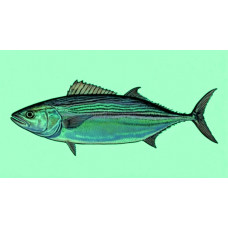Latin name
Sarda orientalis
Other name
Mackerel bonito
Identification
The striped bonito has a spindle-shaped, low body, rather short and compressed at the sides in juveniles. The mouth is rather large and wide. The upper jaw extends behind the eye. The teeth are large, curved and set in a single row. There are 12-20 teeth on the upper jaw and 10-17 teeth on the lower jaw. The teeth on the vomer are absent. There are 8-13 stamens on the first gill arch. The lateral line is single, undulating downwards towards the caudal peduncle. The caudal peduncle is narrow. There is a long medial keel on either side of the caudal peduncle and 2 small keels on either side closer to the caudal fin. The front part of the body has a carapace, the rest of the skin is covered with fine scales. The total number of vertebrae is 44-45, including 20-22 in the caudal region. The swim bladder is absent. The left and right lobes of the liver are elongated and the middle lobe is shortened.
Features of fish fins
Fish of this species have 2 dorsal fins close together. The first dorsal fin has 17-19 barb rays, the length of its base is 28.2-32.7% of the body length to the tail fork. Behind the second dorsal fin is a row of 8 small fins. The pectoral fins are short, made up of 23-26 rays. Between the pelvic fins is a low, forked projection. The anal fin has 14-16 soft rays. Behind the anal fin is a row of 6 small fins.
Fish colouring
The back of the Striped Bonito is blue-green, the sides and belly are silvery, and the upper half of the body is covered with narrow, dark, oblique stripes.
Distribution
Striped bonito are widespread in the subtropical and tropical waters of the Indo-Pacific region. They inhabit the coasts of Australia, China, Colombia, Comoros, Costa Rica, Djibouti, Egypt, Guatemala, Honduras, India, Indonesia, Jordan, Kenya, Madagascar, Mexico, Vietnam, Yemen, Mozambique, Nicaragua, Oman, Panama, Papua New Guinea, Peru, Ecuador, El Salvador, Eritrea, Japan, Saudi Arabia, Philippines, Seychelles, Somalia, South Africa, Sri Lanka, Sudan, Taiwan, South Africa, Tanzania and Yemen. They are found in water temperatures between 14°C and 23°C.
Habitat
Subtropical marine pelagic-neritic oceanodromous species. Occupies coastal waters at depths from 1 to 167 m.
Size
The maximum length of these fish from the beginning of the snout to the fork of the caudal fin is 101.6 cm in the Indian Ocean, and 80 cm in Japanese waters, with a weight of 3 kg. The head is large, its length is 3.25-3.5 times the standard body length to the fork of the caudal fin.
Behavior
Striped bonito form schools with other mackerels of similar size.
Food and feeding habits
They are predators. The basis of their diet is small gregarious pelagic fish, the species of which depend on the geographical habitat. They also prey on squid and prawns. Cannibalism is common.
Reproduction
These fish reproduce by spawning. The eggs are pelagic. Spawning coincides with the rainy season. On the southwest coast of India, adults are caught from May to September and juveniles from October to November. In the south and south-west of Sri Lanka, adults predominate from September to February, while juveniles are found on the west coast from June to August. The eggs hatch in several batches. Average annual fecundity ranges from 80,000 to 1.15 million eggs. Males and females reach sexual maturity at a length to tail fork of approximately 54 cm.
Fishing
It is a valuable commercial fish. It is caught with seines, drift nets and hook and line. It is of interest to recreational anglers.
Relationship with a person
Harmless. Striped bonito meat is marketed fresh, frozen, cured and canned.
| Classification | |
| Phylum | Chordata |
| Class | Actinopterygii |
| Squad | Scombriformes |
| Family | Scombridae |
| Genus | Sarda |
| Species | S. orientalis |
| Features | |
| Conservation status | Least Concern |
| Habitat | Pelagic |
| Life span, years | No information |
| Maximum body weight, kg | 3 |
| Maximum length, cm | 101,6 |
| Sailing speed, m/s | No information |
| Threat to people | Edible |
| Way of eating | Predator |
Striped bonito
Tags: striped bonito

